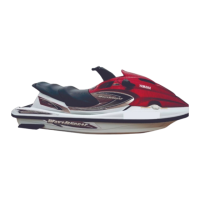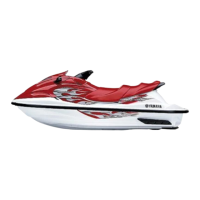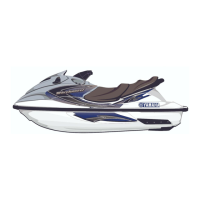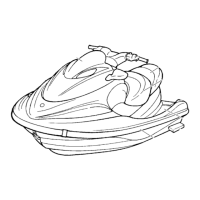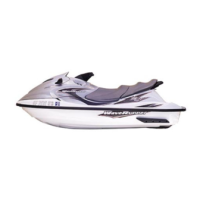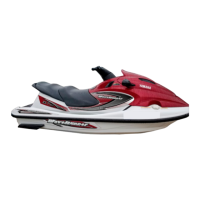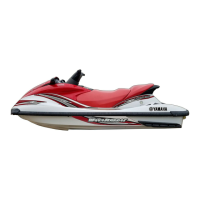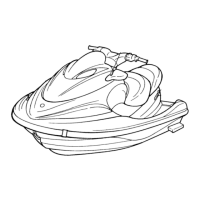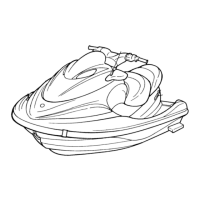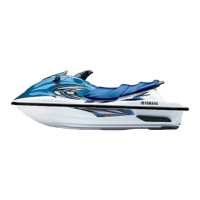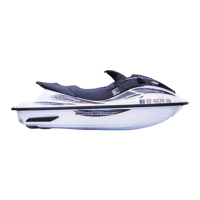Do you have a question about the Yamaha XLT1200 WaveRunner 2002 and is the answer not in the manual?
Details on primary ID, HIN, and engine serial numbers for identification and ordering parts.
Information regarding EPA regulations and approval labels for marine SI engines.
Location and types of warning, caution, and other labels on the watercraft.
Guidelines for safe use, operator age, and essential gear like PFDs.
Safe operating speeds, distance, and conditions to avoid for user safety.
International and USCG navigation rules for safe interaction with other vessels.
Resources and organizations for obtaining further boating safety information.
Identification of key parts and controls on the watercraft exterior.
How to use various controls like throttle, steering, and shift levers.
Explanation of instrument panel displays, indicators, and warnings.
Security feature for starting the engine and setting operation modes.
Recommended fuel types and engine oil for optimal performance and engine life.
Essential safety and functional checks before operating the watercraft.
Initial engine wear-in process for proper performance and longevity.
Steps for launching the watercraft and starting the engine safely.
Familiarization, riding techniques, and safe operation with passengers.
Procedures for starting and boarding in shallow water, from a dock, or deep water.
Steps to take and precautions for if the watercraft overturns.
Techniques for turning, stopping, beaching, and docking the watercraft.
Essential checks and cleaning procedures after using the watercraft.
Guidelines and precautions for safely transporting the watercraft on a trailer.
Steps for storing the watercraft, including flushing and fuel system draining.
Instructions for lubricating various parts for smooth operation and corrosion prevention.
Checks and maintenance for the fuel system, filters, and fuel tank.
Procedures for battery inspection, charging, and storage.
Guidelines for washing, rinsing, and protecting the watercraft's exterior.
Chart detailing routine maintenance tasks based on time or usage intervals.
Checks and adjustments for steering, shift, throttle cables, and QSTS mechanism.
Procedure for inspecting, cleaning, and adjusting spark plugs.
Instructions on how to safely replace fuses in the electrical box.
Technical data and specifications for the watercraft model.
General guidance and a chart to identify and resolve common operational problems.
Steps for handling specific emergencies like clogged intake or dead battery.
Procedure for starting the engine using a booster battery and jumper cables.
Instructions and precautions for safely towing the watercraft in an emergency.
Steps to take if the watercraft becomes submerged or flooded.
Details of the Yamaha Watercraft Limited Warranty terms and conditions.
Information on extended service plans for continued protection after warranty.
Alphabetical listing of topics covered in the manual for quick reference.
Details on primary ID, HIN, and engine serial numbers for identification and ordering parts.
Information regarding EPA regulations and approval labels for marine SI engines.
Location and types of warning, caution, and other labels on the watercraft.
Guidelines for safe use, operator age, and essential gear like PFDs.
Safe operating speeds, distance, and conditions to avoid for user safety.
International and USCG navigation rules for safe interaction with other vessels.
Resources and organizations for obtaining further boating safety information.
Identification of key parts and controls on the watercraft exterior.
How to use various controls like throttle, steering, and shift levers.
Explanation of instrument panel displays, indicators, and warnings.
Security feature for starting the engine and setting operation modes.
Recommended fuel types and engine oil for optimal performance and engine life.
Essential safety and functional checks before operating the watercraft.
Initial engine wear-in process for proper performance and longevity.
Steps for launching the watercraft and starting the engine safely.
Familiarization, riding techniques, and safe operation with passengers.
Procedures for starting and boarding in shallow water, from a dock, or deep water.
Steps to take and precautions for if the watercraft overturns.
Techniques for turning, stopping, beaching, and docking the watercraft.
Essential checks and cleaning procedures after using the watercraft.
Guidelines and precautions for safely transporting the watercraft on a trailer.
Steps for storing the watercraft, including flushing and fuel system draining.
Instructions for lubricating various parts for smooth operation and corrosion prevention.
Checks and maintenance for the fuel system, filters, and fuel tank.
Procedures for battery inspection, charging, and storage.
Guidelines for washing, rinsing, and protecting the watercraft's exterior.
Chart detailing routine maintenance tasks based on time or usage intervals.
Checks and adjustments for steering, shift, throttle cables, and QSTS mechanism.
Procedure for inspecting, cleaning, and adjusting spark plugs.
Instructions on how to safely replace fuses in the electrical box.
Technical data and specifications for the watercraft model.
General guidance and a chart to identify and resolve common operational problems.
Steps for handling specific emergencies like clogged intake or dead battery.
Procedure for starting the engine using a booster battery and jumper cables.
Instructions and precautions for safely towing the watercraft in an emergency.
Steps to take if the watercraft becomes submerged or flooded.
Details of the Yamaha Watercraft Limited Warranty terms and conditions.
Information on extended service plans for continued protection after warranty.
Alphabetical listing of topics covered in the manual for quick reference.
| Manufacturer | Yamaha |
|---|---|
| Model | XLT1200 WaveRunner |
| Year | 2002 |
| Category | Boat |
| Displacement | 1176cc |
| Seating Capacity | 3 persons |
| Fuel Type | Gasoline |
| Hull Material | Fiberglass |
| Engine Type | 2-stroke |
| Width | 4 ft |
| Storage Capacity | 18.5 gallons |
